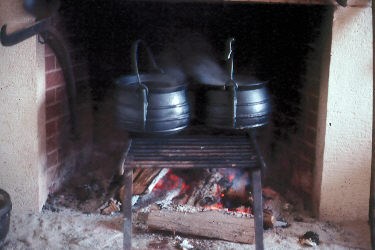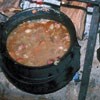
Open hearth cooking is the oldest way of cooking. Before cook stoves came into existence, fireplaces were commonly used. A cook knew how to prepare the fire for a day of planned cooking. The cook would rise early in order to start the fire for the day's cooking. The fire was also the last thing at night the cook tended to, banking it for the next morning's use. The fire is something to be studied. If you do not understand how a fire operates, you will not be able to control it. Not just any wood will do. Hardwoods are the best. Ash, oak, hickory, hard maple, or dogwood are some hardwoods that are good to burn. "The two essential properties of the best cooking woods are that they generate an even, intense heat and that they produce a good supply of red hot coals as combustion proceeds." Hardwoods accomplish both properties. Blazing fires do look dramatic for display, but were used little for useful cooking. Cooks used a controllable fire, which roasted and toasted foods. Boiling, simmering, and stewing foods were done under a small flame. To utilize still further the fire's energy, its coals were raked up, placed on the lid, and then placed underneath the Dutch ovens to bake. On rainy days, when the wood supply got wet, it was brought into the house and stacked around the back and sides of the fireplace. The heat of the fire would dry the wood out. This technique of drying wet wood in a fireplace is seen in old photographs of the period. The area you were settled in had a great deal to do with what wood you had available. Some areas had only soft wooded trees growing around them. Bents' Fort had a problem with obtaining the proper wood for cooking, because of the softwoods native to their surroundings. Without the hardwoods, coals were difficult to accumulate. Baking is only successful with the aid of coals. Although early American cooks used long-handled pots and utensils, being burned and even burning one's house down were frequent misfortunes, especially during this period of rudely constructed chimneys. The floor near the cooking hearth was swept constantly, and the hearth itself scrubbed often to keep it free from grease. Dripping pans were used when roasting or boiling to prevent the grease from dripping directly on the hearth. Scalding was a common accident when people used lugpoles. Lugpoles were sturdy, very green, saplings that rested on the projecting inner ledges of the fireplace throat six or seven feet above the hearth. If this big pole were not replaced frequently, it would burn through, causing damage to those around the hearth. Lugpoles were replaced by cranes. The crane is a large iron bracket hinged to the fireplace jamb. From "S" hooks and trammels placed on it, the cook suspended cooking pots over the fire. The cranes' hinges allowed the cook to swing the pots on and off the fire safely. Many implements were used by the cook. Each one performed a useful task. Different types of tools used to care for the fire were: shovels, pokers, tongs, and bellows. Without these implements, one would not have been able to cook. Tending to the fire was important because without doing so, one would not be able to have available the right amount of coals for baking or enough flames for boiling. Other versatile cooking implements are: peels, posnets , a cooking pot with 3 legs and a long handle, spiders, bird ovens, coffee roasters, tilting teakettles, ember tongs, salamanders, tin kitchens, Dutch ovens, clock jacks, griddles, waffle irons, and kettles of all sizes. Not all kitchens were supplied so lavishly. The general arrangements were sparse. This did not hinder the cook's basic cooking techniques. One could turn out the prepared dishes with a surprisingly high degree of accuracy, and with remarkably tasty results. That was because of the cook's resourcefulness. Pots, which were designed for a particular cooking technique, were used in a variety of other ways as well. An average cook had a skillet or frying pan and would own a griddle, which was useful for baking biscuits, muffins, small cakes, pancakes, and sautéing. For pots that did not have fat on them, a trivet was required for supporting it. Spoons for stirring, forks for piercing, and spatulas for turning were all-important implements used. Cookbooks were not common items in the 1840s. All good cooks knew their recipes by heart. If a cookbook were found in that era though, you would see recipes for French bread, ladyfingers, sponge cake, and puff. The wood, knowledge of fires, implements, and of course, safety, are all a part of open hearth cooking this type of cooking is continuous process of learning. New recipes tried against old are always a challenge. The best teacher of all in open hearth cooking is just experiencing it and the old cliché, if at first you don't succeed, try, try again! Information in this section was adapted from an article on open hearth cooking written by Alice Maffett, a former park ranger at Fort Scott NHS.
|
Last updated: July 30, 2016

